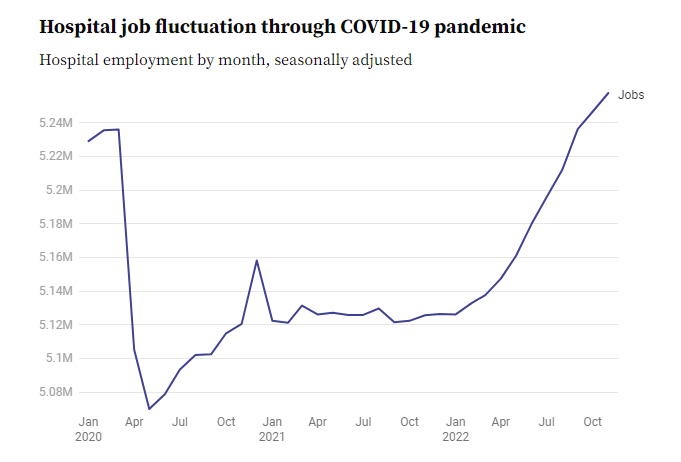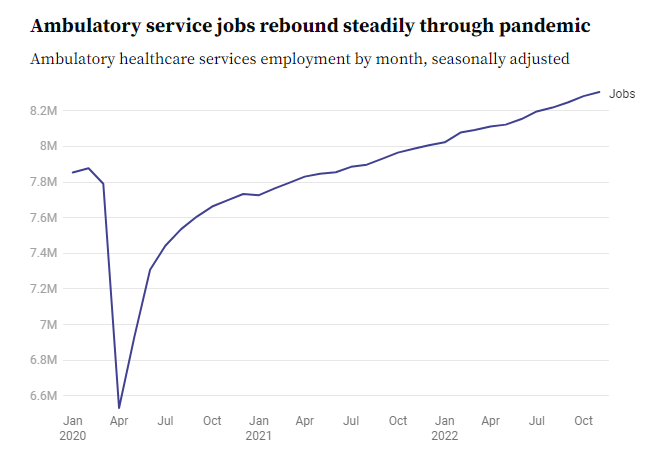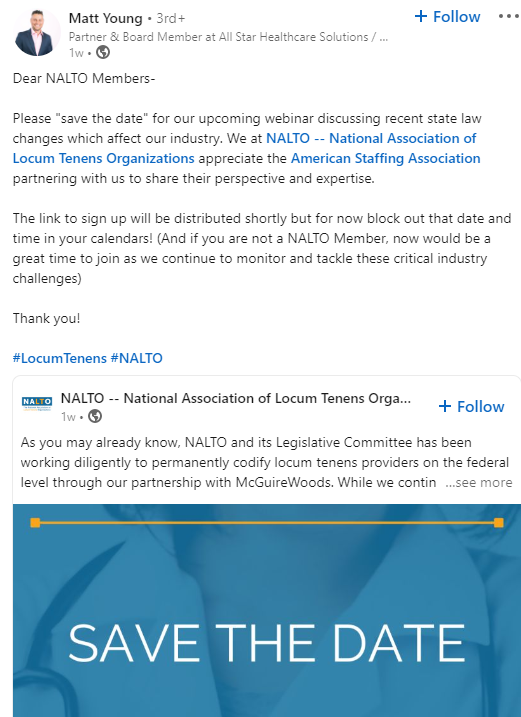In This Issue:
- Fitch: Nonprofit Hospital Staffing Challenges Ease While Healthcare Staffing Growth Remains Strong
- Elite365 – Healthcare Workforce Solutions Hires Industry Leader to Expand into Locum Tenens
- Consilium Staffing Named a ‘Top 100 Place to Work’ for 2022 by The Dallas Morning News
- Healthcare Staffing Challenges in 2023
- Health Carousel Earns Recertification as an Ethical Recruitment Firm
- Reducing Hospital Costs with Locum Tenens Physicians
- Survey: Demand for Mental Healthcare Has US Psychologists Overwhelmed
- Healthcare Sector Added 45K Jobs in November as Pandemic Recovery Continues
- Join us at the NAPR/NALTO® 2023 Annual Convention February 5-7, 2023 in San Antonio, Texas!
- Socially Speaking: Social Posts of Note from All-Star, Wilderness, Weatherby, Hayes & more
Fitch: Nonprofit Hospital Staffing Challenges Ease While Healthcare Staffing Growth Remains Strong
Overall Temporary Staffing, Travel Nurse Staffing Show Signs of Cooling
(Edited from Healthcare Dive article by Hailey Mensik, 12/14//2022; SIA Daily News, 11/30/2022, & SIA Healthcare Staffing Report, 12/8/2022)
Article Highlights:
- Staffing shortages across nonprofit hospitals appear to be improving incrementally, according to a report released by Fitch Ratings on December 13.
- The report points to recent data from the Bureau of Labor Statistics (BLS) showing hospitals and ambulatory service providers added 11,000 and 23,300 jobs, respectively, from October through November. Job openings in the sector also declined to 8.7% in October from 9.1% in September.
- However, the ongoing COVID-19 pandemic and more cases of influenza and RSV are causing capacity issues that pose a major near-term risk to labor costs.
- Continued growth in healthcare staffing–allied healthcare and locum tenens specifically– boosted overall temporary staffing revenue by a median of 12%, year-over-year, in October.
- Locum tenens staffing executives confirm continued high demand among healthcare facilities for physicians and advanced practitioners willing to work ‘ad hoc.’
Winter Virus Waves, Resignations Could Reverse Trend
Hospitals have faced heightened labor costs amid inflation and pandemic-driven burnout throughout the year.
More recently, nonprofit hospitals have seen labor improvements, but higher patient volume amid winter virus waves could boost the need for contract labor and reverse that progress, according to a Fitch Ratings report.
Also, despite recent job gains in the sector, the number of resignations remains elevated, according to the report.The report said resignations in the healthcare and social assistance sector were at 2.5% in October, compared to an average rate of 1.6% from 2010 to 2019.
That means workers are willing and able to leave their current roles, while highlighting “the pressure on health systems to provide increased wages and improved working conditions to employees,” Fitch Ratings Director Richard Park said.
The hiring rate in the sector declined from 3.6% in September to 3.4% in October, though that’s still above the 2.8% average from 2010 to 2019, according to the report.
In an effort to quell ongoing shortages, many systems have boosted wages. Hospital employees’ average hourly earnings have risen significantly during the pandemic, growing by 17% from February 2020 to October 2022.
Average hourly earnings for ambulatory healthcare workers grew by 12% during that period while earnings for private-sector employees overall grew by 14%.
Travel Nurse, Locum Tenens Staffing Lead Temp Staffing Growth
Meanwhile, trends for healthcare staffing growth remain encouraging, boosting median temporary staffing revenue, which rose by a median of 12%, year-over-year, in October.
SIA’s US Staffing Industry Pulse Survey Report: November 2022 Selected Highlights, released Thanksgiving week, covers October data and includes responses from 153 staffing companies, both within, and outside of, healthcare.
On November 30, SIA reported, “Travel nursing staffing growth cooled considerably but still posted the fastest growth among all segments, with revenue up a median 27% year-over-year.”
In line with travel nursing trends, locum tenens staffing revenue increased by a median of 27%. “Allied healthcare and per diem also posted modest growth, with October revenue up by a median 21% and 13%, respectively,” SIA reported.
“Outside of healthcare, the strongest growth was in life sciences, up by a median 11%. This was followed by IT, up 10%, and marketing/creative, up 8%. No segments reported negative median year-over-year changes in revenue.”
The report, which includes selected highlights from the Pulse survey, is available to corporate SIA members; the full, 31-page Pulse report is available only to companies that took part in the survey. It contains insights on revenue trends, bill rates, orders, gross margins, and recruiting/sales difficulty–as well as a six-month outlook for each staffing skill segment.
For more information on participating in the next survey, which takes place in January, contact SIA Senior Research Analyst Curtis Starkey (cstarkey@staffingindustry.com).
December Report Highlights Allied HC Staffing Growth
SIA’s last Healthcare Staffing Report of 2022 focused on record allied healthcare and locum tenens staffing demand: “Total allied healthcare temporary staffing revenue increased by 103% from the first half of 2021 to the first half of 2022,” according to selected findings from SIA’s Allied Healthcare Benchmarking Survey.
Of the 16 participating allied healthcare staffing firms, hours billed increased by 62%, year-over-year, in the first half of 2022. Allied healthcare staffing bill rates increased by an average of 25% from the first half of 2021 to the first half of 2022.
This continued demand complements SIA’s US staffing industry forecast, which projects the allied healthcare staffing segment will expand 20%, year-over-year, in 2022 with continued growth of 8% in 2023.
“Respiratory therapists continue to hold the largest share of reported allied healthcare revenue by occupation in the first half of 2022, followed by clinical lab technicians and radiology/MRI technologists,” SIA reported.
Respondents said cardiac catheterization technologists were the most difficult candidates to recruit, likely due to fierce competition and shrinking talent pools. Speech therapists were the second-most-difficult candidates to recruit.
Locum Tenens Staffing Demand Continues
SIA said its staff’s conversations with locum tenens staffing executives confirm continued high demand among healthcare facilities for physicians and advanced practitioners willing to work ‘ad hoc.’
An aging population, life-prolonging technological advances, and more chronic diseases requiring complex care are expected to cause a physician shortage of between 37,800 and 124,000 physicians by 2034, according to the American Association of Medical Colleges.
Moreover, as access to mental health services improves, employment of psychiatrists is projected to increase by 9% between 2021 and 2031, according to the US Bureau of Labor Statistics.
“Adding to the challenge of recruiting and retaining physicians, there are heightened concerns around physician and advanced practice providers’ (APPs’) burnout,” SIA noted.
According to survey data released by the Mayo Clinic in December 2021, physicians’ and APPs’ intentions to reduce hours were high, at 31% and 28%, respectively. Meanwhile, physicians’ and APPs’ intentions to leave their practice within two years were 23% and 33%, respectively.
Corporate SIA members can download the Locum Tenens Market Growth Assessment report for a deeper dive into the locum tenens segment.
All News Is Locums
Elite365 – Healthcare Workforce Solutions Hires Industry Leader to Expand into Locum Tenens
(Edited from BusinessWire news release, 12/7/2022)
Elite365 – Healthcare Workforce Solutions has appointed healthcare staffing veteran Russel Hicks as president of its new locum tenens division. Hicks will also join the company’s board. Building on Elite365’s commitment to supporting healthcare organizations, Hicks’ 27 years of healthcare staffing experience will propel this service forward and support the company’s mission to elevate patient outcomes.
As the urgent talent crisis continues in healthcare, organizations need trusted partners with strong provider networks to develop talent and meet demand. With Elite365’s deep industry expertise, the company is uniquely positioned to fill provider gaps and offer critical locum tenens support.
“Russel’s industry experience and entrepreneurial grit will be invaluable as we launch our locum tenens division,” Elite365 CEO Tracy Clark said. “He has proven expertise in building great teams and strong cultures. His ability to launch, lead and grow healthcare staffing companies is unparalleled.”
Hicks joins Elite365 from Provide LT where he served as president and CEO. While there he helped establish the company’s core locum tenens services and mold its internal culture. Before that Hicks was the founder and president of Martin Fletcher, a healthcare staffing firm focused on locum tenens and permanent placement.
“I’m inspired by the Elite365 team and their desire to build a quality organization that puts people and patient care first,” Hicks said.
Elite365 is backed by Regal Healthcare Capital Partners, “a control growth equity and buyout firm focused exclusively on healthcare services,” according to Elite365’s news release. For more information visit: www.regalhcp.com.
Consilium Staffing Named a ‘Top 100 Place to Work’ for 2022 by The Dallas Morning News
(Edited from PRNewswire release, 11/14/2022)
The Dallas Morning News has named Consilium Staffing to its “Top 100 Places To Work in Dallas-Fort Worth” (D-FW) for 2022.
Run by research partner Energage, the Top 100 Places To Work is based on an extensive employee survey celebrating excellence in areas like company leadership, compensation, training, workplace flexibility, and diversity.
A record-breaking number of nearly 6,000 companies were nominated and more than 156,000 employees were surveyed in 2022, the 14th year for the Top 100 awards in D-FW.
Approximately 87% of Consilium team members participated in the survey and reported three main areas where the company excels: inclusion, cross-team cooperation, and strong values.
The results also revealed:
- 98% of employees think Consilium makes them feel included.
- 98% of employees think Consilium operates by strong values.
- 94% of employees at Consilium feel that their job is meaningful.
Winners were honored during a November 9 awards celebration and featured in the Top 100 Places To Work magazine distributed in The Dallas Morning News on November 13.
“Our culture is one of inclusion, empowerment, transparency, and faith, and we are so grateful our employees embrace our mission to bring the best patient care possible to communities around the nation,” Consilium Executive Vice President Matthew Baade said.
Healthcare Staffing Challenges in 2023
(Edited from Maxim Healthcare Staffing blog post, 10/28/2022)
According to the US Department of Labor (DOL), healthcare jobs are projected to grow 13% from 2021 to 2031, which is much faster than the average for other occupations. This potential increase could lead to about 2 million new jobs over the decade.
While this is good news for healthcare professionals, healthcare providers are facing many staffing issues that have affected the quality of care in many institutions. But how can healthcare organizations find the professionals they need?
For many hospitals and health systems, partnering with a locum tenens staffing firm has made all the difference. Like Maxim Healthcare Staffing, most locum tenens agencies are committed to connecting top healthcare talent with work that matters. Their resources and expertise can help solve the myriad staffing challenges healthcare faces today.
Common Staffing Challenges
Some of the most common staffing challenges in healthcare include:
- Burnout – Over the past few years the COVID-19 pandemic has created more stress for healthcare professionals through longer hours and the risk of catching the virus, among other challenges. These factors have caused many healthcare workers to become “burned out” and change either jobs or career paths.
- High Turnover – Whether because of burnout, increasingly challenging personal finances, or undesirable workplace requirements, more healthcare workers change jobs more often now than ever before. High turnover rates lead to more frequent staffing shortages.
- Too Few New Healthcare Professionals – The DOL reports there are almost 2 million openings for healthcare professionals each year. This statistic reflects the critical need for new people to enter the healthcare field.
- Aging Population – According to the US Census Bureau, the “baby boomer” generation is now estimated to number roughly 73 million people. All ‘boomers’ will be 65 or older by the end of this decade, further straining an already-fragile healthcare system. In addition to the growing volume of older patients, advances in medical technology help people live longer, further increasing demand for healthcare professionals.
Health Carousel Earns Recertification as an Ethical Recruitment Firm
(Edited from Cision/PRNewswire release, 11/15/2022)
Health Carousel, LLC, recently announced it has received recertification as a “Certified Ethical Recruitment Firm” in the recruitment of foreign-educated healthcare professionals by the Alliance for Ethical International Recruitment Practices, a division of CGFNS International, Inc.,
The announcement marks Health Carousel’s first recertification since first achieving the accolade in 2020. Recertification is valid for two years through September 2024, contingent upon Health Carousel completing annual certification requirements.
The Alliance certification process includes a review of contract practices, discussions with references, and surveys and interviews of health professionals that have worked with Health Carousel. The review findings must demonstrate the firm is committed to ethical, responsible, and transparent recruitment practices as defined by the Alliance’s Health Care Code for Ethical International Recruitment Practices.
The Code is maintained by a multi-stakeholder Board of Governors, including leading human resource and nursing associations, nurse representative organizations, and recruiters.
As a Certified Ethical Firm, Health Carousel commits to continual education of the healthcare professionals it recruits and oversight by the Alliance.
“We are proud of Health Carousel’s business practices, policies and procedures that have earned us recertification as a Certified Ethical Firm by the Alliance,” Health Carousel CEO John Sebastian said. He noted that Health Carousel is also a founder of the American Association of International Healthcare Recruitment and a member of Ethisphere’s Business Ethics Leadership Alliance.
Reducing Hospital Costs with Locum Tenens Physicians
(Edited from D&Y post updated 9/20/2022)
As recruiting costs and physician wages increase, healthcare organizations face the challenge of balancing cost savings with quality care.
Patient care should not be compromised when reducing the annual cost spent on hiring physicians. Partnering with a locum tenens staffing agency can be a viable way to reduce overall staffing costs while increasing revenue.
Reducing Cost and Risk With Locum Tenens
Effectively onboarding a physician is not only challenging but also a significant investment for a hospital.
The three biggest financial benefits to hiring a locum tenens physician are:
- Recruiting costs
- Malpractice Insurance
- Physician compensation
RECRUITING COSTS: Up to $88,000 per physician
Recruiting physicians is a costly, labor-intensive process. By contracting physicians through a healthcare staffing company, healthcare facilities can significantly cut costs associated with recruiting, interviewing, sign-on incentives, and relocation bonuses.
Hiring a locum tenens physician makes sense in many scenarios, specifically to maintain optimum patient care amid physician shortages where caseload demands are challenging for staff physicians to meet.
From facility expansion to unplanned physician absences, there are many staffing complexities within the healthcare industry. Both revenue and patient care improve when medical facilities use locum tenens to bridge staffing gaps.
MALPRACTICE INSURANCE: Up to $100,000 per physician annually
The cost of malpractice insurance for physicians can reach up to $100,000 annually. Locum tenens staffing agencies cover this cost for the locum tenens providers to contract with a facility.
The locum tenens benefit stretches beyond not having to provide malpractice insurance: Using locum physicians reduces hidden, unplanned costs overall. An overworked, fatigued clinician is not at their best and can pose a risk to the health and safety of your patients. Healthcare facilities benefit from having locum tenens alleviate the overall workload.
PHYSICIAN COMPENSATION: Up to $400,000 per physician annually
Annual salary, insurance, and benefits can cost hospitals as much as $400,000 per year for a full-time physician. Because locum tenens providers are independent contractors, healthcare facilities don’t have the overhead of an annual salary or benefits package, thereby reducing annual physician compensation costs.
At first glance, locum tenens pay rates may appear high, but when patient care and revenue stream are compromised due to lack of sufficient staffing, you can consider locum tenens a worthwhile investment.
LOST REVENUE: More than $1.5 million per physician annually
The hard costs of hiring a full-time physician are significant, but the expense of a physician vacancy is even more costly.
Reducing Costs With Locum Tenens
Locum tenens providers can fill staffing needs in the short or long term, ensuring that your healthcare organization has the available resources to continue quality patient care.
By eliminating recruiting costs, malpractice insurance, and physician compensation, and by minimizing lost revenue, locum tenens providers can help healthcare organizations reduce overall costs while improving their bottom lines.
The Healthcare Staffing Story
Survey: Demand for Mental Healthcare Has US Psychologists Overwhelmed
(Edited from American Psychological Association (APA) news release, 11/15/2022, & HealthDay news release by Cara Murez, 11/16/2022)
Though the COVID-19 pandemic has eased, a mental health crisis persists, a nationwide survey of US psychologists reveals.
Growing demand for help with depression, anxiety, and substance use issues means many psychologists across the United States are unable to take on new patients, according to the American Psychological Association’s 2022 COVID-19 Practitioner Impact Survey.
“The national mental health crisis continues,” APA CEO Arthur Evans Jr., said. “If you are struggling, know that you are not alone. Psychological science shows that social support is key to developing resilience, so if you are having difficulty accessing care in a timely way, reach out to others to find support and identify ways to cope.”
Almost 2,300 licensed psychologists nationwide responded to the APA’s third annual practitioner survey in late September and early October.
Psychologist Capacity Maxxed Out
Sixty percent of psychologists reported having no openings for new patients (slightly down from 65% in 2021), while 72% said they have longer waitlists than before the pandemic. On average, psychologists said 15 people a month contact them seeking new care.
In all, 79% said they have seen more patients with anxiety disorders since the pandemic began. About 66% have seen increased demand for depression treatment; 47% for substance use treatment, and 64% for trauma. About two-thirds of responding psychologists said patients’ symptoms are more severe this year.
Young people, especially 13- to 17-year-olds, represented the largest increase in patients seeking care. Many psychologists also saw a need for more care in children under 13 and among 18- to 25-year-olds.
Nearly half of responding psychologists (46%) reported a rising number of healthcare workers seeking treatment since the start of the pandemic.
“Having timely access to psychological services is critical for addressing the needs of those diagnosed with behavioral health challenges,” Evans said in an association news release. “But we need to tackle this problem with a variety of solutions beyond individual therapy.”
He cited the need to support and expand the psychologist workforce; integrate behavioral health into primary care; and use technology and innovation to reach more patients.
About 11% of psychologists now see all patients in person, up from 4% in 2021. More than half (58%) see some patients remotely and some in person. About 31% see all patients via telehealth.
The APA noted that telehealth can expand access to care for patients from underserved communities, including those in rural areas and people of color. The APA continues to advocate for expanded coverage of telehealth by insurance companies.
Amid high patient demand, about 45% of psychologists said they feel burned out. But 60% said they have sought peer consultation or support to manage it. About 77% said they were able to practice self-care and 63% said they have been able to maintain a positive work-life balance.
Healthcare Sector Added 45K Jobs in November as Pandemic Recovery Continues
(Edited from Healthcare Dive article by Hailey Mensik, 12/2/2022)
Dive Brief
- The healthcare sector added 45,000 jobs in November, compared to about 54,000 in October, according to preliminary data out Friday from the US Bureau of Labor Statistics.
- Ambulatory health services led the gains with 23,000 added jobs, followed by hospitals, nursing, and residential care facilities, each adding about 10,000 jobs.
- Similar to last month’s jobs report, the BLS reiterated that employment in the industry has grown much faster this year than last. Healthcare has added an average of 47,000 jobs per month this year compared to 9,000 in 2021.
Dive Insight
Healthcare jobs recovered from early pandemic losses this year, with strong and consistent gains, particularly among ambulatory healthcare services and hospitals.
Since November 2021, hospitals have added more than 130,000 jobs. Ambulatory services have added some 300,000 jobs.

Chart created by Hailey Mensik – Source: The Bureau of Labor Statistics
Nursing and residential care facilities have boosted the industry’s job gains overall this year, after those facilities suffered major job losses throughout the first year of the pandemic.
Every sector within the healthcare industry added jobs in November. Other notable gains came from outpatient care centers and home health services, both adding about 6,000 jobs during the month.

Chart created by Hailey Mensik – Source: The Bureau of Labor Statistics
Tools to Try/News to Use
Join us at the NAPR/NALTO® 2023 Annual Convention
February 5-7, 2023 in San Antonio, Texas!
General Information
Don’t miss out! Attend the 2023 NAPR/NALTO® Annual Convention, February 5-7, 2023, in San Antonio, Texas. Start the new year off at San Antonio’s famous River Walk.
No matter where you lie in the locum tenens landscape, there is a place for you at this conference.
Connect, consult, and convene, but what does that really mean?
Collaborate with colleagues.
The NAPR/NALTO® Annual Convention delivers the face-to-face networking and peer learning experiences that our industry values: Find common ground. Share ideas. Discover a different perspective. Get reacquainted with old friends and meet new ones!
Connect with top-level speakers and industry experts.
The work of the NAPR/NALTO® Convention Planning Committee ensures you’ll learn from the industry’s best. From the opening keynote to the closing session, gain the critical knowledge, tools, and resources you need to succeed.
Consult with trusted partners.
Our interactive exhibit hall lets you explore innovative solutions for the challenges you face every day. Strengthen relationships with existing vendors or forge relationships with new ones.
Convene with confidence.
The Hyatt Regency San Antonio Riverwalk is committed to ongoing engagement with medical experts as well as federal, state, and local officials for the health and safety of its guests and employees. View the hotel’s full health and safety commitment here.
Count on gaining a wealth of industry knowledge by attending this conference–knowledge to help jumpstart your career or business into a powerful new year!
Registration Fees
Registration includes all general and concurrent sessions, Sunday night Presidents’ Welcome Reception, Monday’s Networking Luncheon, Monday night social event, two continental breakfasts, and all refreshment breaks.

How ‘Bout This?
South Carolina Hospital Fills Empty Wing with Prisoners to Help Avoid Closure
(Edited from Becker’s Hospital CFO Report article by Noah Schwartz, 11/28/2022)
Chester (S.C.) Medical Center is filling an empty wing of its hospital with 36 inmates as a measure to help stave off closure, The Herald reported Nov. 28.
The wing was outfitted with $3.3 million in security equipment to meet prison compliance standards, including 60 cameras, fences, barred windows and heavy-duty locks. Sixty new jobs will be created by adding inmates to the wing, and taxes will pay for the inmates’ care.
Chester Medical faced uncertainty before it was taken over by the Charleston-based Medical University of South Carolina in 2019, and the center hopes that this move will help the hospital avoid the closures that have plagued other rural hospitals.
“Communities like Chester are under great, great pressure to close their hospitals,” MUSC CEO Patrick Cawley, MD, told The Herald. “It’s hard to maintain the hospital, but this will prevent that from happening or make it much, much, much less likely.”
Addressing community safety concerns, Chester County Sheriff Max Dorsey told The Herald that law enforcement has a “comprehensive safety plan in place.”
California Offers $1.3B in Healthcare Worker Retention Bonuses
(Edited from Becker’s Hospital Review article by Alexis Kayser, 11/30/2022)
The California Medical Association, along with the state’s governor and legislature, have allotted $1.3 billion of the state’s budget toward retention bonuses for healthcare workers.
Signed by California Gov. Gavin Newsom on June 30, the bill, states that the legislature believes stability in the healthcare workforce will aid in pandemic management and help address other public health issues. Additionally, the bill said providing healthcare workers in 24-hour facilities with retention payments will advance the state’s effort to promote stability and retention in the healthcare workforce.
Click here to learn more details about eligibility requirements or payment administration.
Each eligible worker can receive a bonus of up to $1,000. They must register with the Department of Health Care Services by Dec. 21, then submit an application via the online portal, which opened Nov. 29 and will close Dec. 30. Eligible facilities that employ physicians will be responsible for applying on the physicians’ behalf.
The state medical association said payments are expected to be issued in January.












